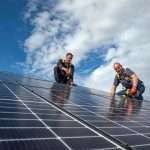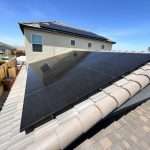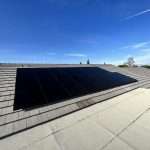Many factors make a roof more or less suitable for solar panels. Still, while some qualities make a rooftop solar system installation difficult, others have a minimal impact on solar energy production.
Two main factors influence the performance of your solar panels: orientation and angle. This article summarizes the most crucial data points to help you choose the correct orientation and angle for your solar panels.
Solar panels facing east or west produce about 20 percent less electricity than if they were facing south. However, you will have to face north in the northern hemisphere for the best results.
Solar Panel Installation Angle
A solar panel installation angle is usually chosen to maximize output and efficiency. Solar panels with a higher angle produce electricity more efficiently than those facing a lower angle. The most common solar panel installation angle is 18° or 22°.
Your solar panels should be positioned at their optimal angle when it permits them to get the most direct, perpendicular light. Solar panels should take the sun’s direct path to capture solar energy more effectively.
The installation of solar panels should be done at a relative angle to or the same as the latitude of your residence (on a south-facing roof).
Solar Panel Direction When Mounted
It determines the amount of energy they can produce. For a given property and system, the ideal angle for your solar panels is somewhere between 30 degrees and 45 degrees.
The closer to this ideal angle your panels are installed relative to a location’s latitude, the more electricity they will generate.
Solar Panels’ Optimal Orientation
Your solar panels’ optimal orientation depends on your geographic location and the weather in your area. The more sunlight hits your roof during the summer months and the better weather you get during winter, the easier it will be to generate power with solar panels.
Solar Panels’ Installation During the Winter
In the winter, the sun is low on the horizon. One way to counteract this is installing solar panels at an angle steeper than your latitude—ideally, about 60 degrees.
Lower-angle panels can also backfire because snow won’t easily slide off your range. As a result, there will be persistent snow cover and less electricity generated.
Solar arrays with their panels facing north produce more electricity than those facing southwest since they expose them to a colder climate while they’re still tilted at an angle that requires less sunlight.
Conclusion
Solar panels are a terrific method to lower your energy costs and support the environment when the globe is working to adopt sustainable energy alternatives.
If you need to set up a solar power system on your roof, know that the orientation and angle are more important than the location. If installed correctly, a solar panel system can produce the most electricity in areas with lots of sun exposure.
Solar energy is the future of electricity, and at ARC Energy Solutions., we are committed to assisting homeowners in maximizing this sustainable resource. Please get in touch with us right away if you’re interested in learning more about solar energy and how it may improve your house. We would be pleased to go over your options with you.










